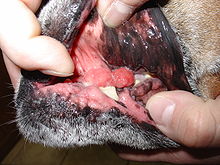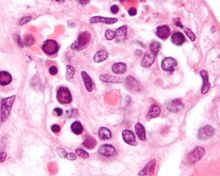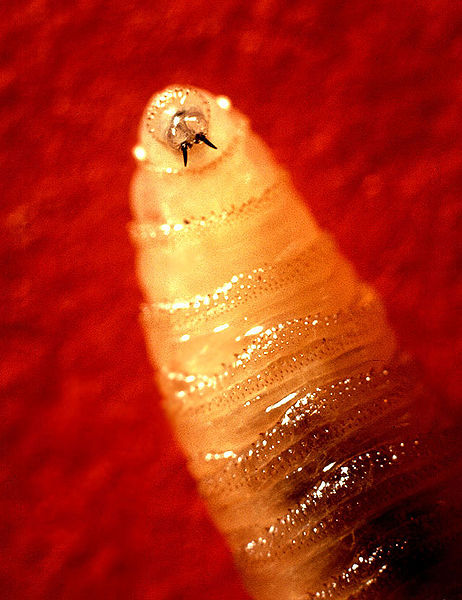Do You Want To Interact?
Interactions
Although the maned wolf has no known predators, the animal still interacts with other organisms. From being a parasitic host, to being involved in symbiotic relationships, this organism can absolutely form some long lasting relationships!
Maned wolves can severely suffer from diseases and
parasites, which are mainly transferred from wild and domestic dogs
fighting with the maned wolves. Some
important diseases transferred to maned wolves include dioctophymiasis, cystinuria, severe
gingival hyperplasia (picture at left), and parvovirus (Dietz 1985).


Being found in a great number of captured maned wolves, cystinuria is an inherited illness that causes amino acids to be excessively eliminated from the body through urine. This disease was found in 6 out of 8 wild maned wolves tested; however, the effects of cystinuria on wild populations of this organism is not known (Fletchall 1995).
 The most devastating parasite found in maned wolves is the
giant kidney worm (Dioctophyme renale). Maned wolves
contract this nasty parasite by ingesting intermediate hosts such as
fish and mollusks. The giant kidney worms may also be
passed to the maned wolf through consumption of Solanum lycocarpum.
(Go to Nutrition)
The horrible parasitic worm always harms and destroys the
right kidney, which can potentially kill the maned wolf (Fletchall 1995). Other parasites
found in wild maned wolves are nematodes from the families: Trichuris, Ancylostoma,
and Toxocara, cestodes,
ticks,
and screwworm larvae (picture at left) (Dietz 1985).
The most devastating parasite found in maned wolves is the
giant kidney worm (Dioctophyme renale). Maned wolves
contract this nasty parasite by ingesting intermediate hosts such as
fish and mollusks. The giant kidney worms may also be
passed to the maned wolf through consumption of Solanum lycocarpum.
(Go to Nutrition)
The horrible parasitic worm always harms and destroys the
right kidney, which can potentially kill the maned wolf (Fletchall 1995). Other parasites
found in wild maned wolves are nematodes from the families: Trichuris, Ancylostoma,
and Toxocara, cestodes,
ticks,
and screwworm larvae (picture at left) (Dietz 1985).
Because the animal is able to consume seeds from fruits and disperse them through defecation, maned wolves are in a symbiotic relationship with the plants that they feed on. In a study done by J. C. Motta-Junior and K. Martins, they found that all of the fruit species consumed by wolves were still intact after going through the maned wolf's digestive tract. 91.7% to 100% of the seeds were unharmed, and 14 out of 16 types of the plants tested had successful germination. These results qualify the organism as an acceptable seed disperser. Also, even though it only takes about 20 to 30 minutes for the seeds to travel through the maned wolf's digestive system, the organism walks a lot at night and has a large home range, causing the seeds that are consumed to be very well dispersed (Motta-Jr., Martins 2002).
In different study done by J. A. Lombardi and J. C. Motta-Junior, seeds were collected in feces from one fruit and were seeded to germinate all over South America in different environments. The germinations proved that the route through the maned wolf’s digestive tract allowed seed germination; however, it was discovered that the route is not necessary for effective germination to take place (Lombardi, Motta-Jr 1993).
The seeds also may go through a process that greatly increases their germination rate. Because maned wolves often defecate on the nests of leafcutter ants, the scavenging ants then take fruit and wolf feces that contain the seeds into the ant nest, using the feces and seeds to fertilize their fungus grounds. Afterwards, the ants put the seeds in waste piles outside of their nest (wikipedia.org/wiki/Maned_wolf).
As for interactions
with humans, the maned wolf is usually a very shy animal and runs
away when startled. This causes the organism to have a little direct threat
to humans; however, humans cause multiple threats to the maned wolf. Just a few examples are that
chicken farmers may kill maned wolves for preying on their chickens, maned
wolves are regularly killed on highways from vehicles, and humans are altering the maned wolf’s
habitat to agriculture land (wikipedia.org/wiki/Maned_wolf).
Back to Home
